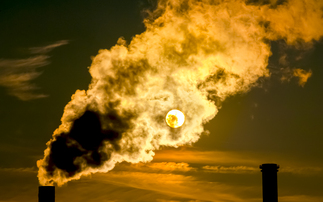
Industry Voice: Schneider Electric's Kelly Becker looks down the barrel of the climate crisis and considers how to fix it
The next eight years will be pivotal for the future of our planet. In our fight against climate change and to have the best chance of limiting temperature rises to 1.5˚C, we must halve global emissions by 2030.
In the run-up to COP26, the increasing frequency of recent extreme weather events and the publication of several reports on the climate emergency has injected a heightened sense of urgency and crystalised what we have known for decades: human activity is changing our planet.
In August, the Sixth Assessment Report of the UN Intergovernmental Panel on Climate Change (IPCC) predicted that average global temperatures could potentially breach the 1.5˚C limit set in the 2015 Paris Climate Agreement ten years sooner than expected.
Similarly, a report in April from the International Energy Agency (IEA) - the 'Global Energy Review 2021' - forewarns that global energy-related CO2 emissions will rise by 1.5 billion tonnes in 2021, taking the total to 33 billion tonnes. Reversing the decline caused by the Covid-19 pandemic, this will primarily be driven by a strong rebound in demand for fossil fuels in electricity generation.
The power is in our hands
Among all this bad news, however, there is more than a glimmer of hope. Yes, there's a lot to be done to halt the worst effect of global warming but let's be clear: it's absolutely achievable and there's a great deal of willingness to get there. According to this year's Schneider Electric sustainability research, the majority of British and Irish businesses say they have set targets to reduce emissions. Business leaders believe they are on track to achieve their goals and most respondents think Britain will successfully reach key net zero milestones.
There has never been more significant support and desire to tackle the climate crisis from policymakers, businesses and consumers. And, we already have the technology and solutions to make real inroads into creating a net zero future.
In the fight against climate change, some progress has already been made. Awareness is high, with around three quarters (75 per cent) of UK respondents to recent consumer research now concerned about the threat of carbon emissions to the planet.
The cost of clean, renewable energy is becoming cheaper and policymakers, including those in the UK and Ireland, are strengthening their climate policies and commitments on the road to achieving net zero by 2050.
We surveyed 850 key decision-makers from across a broad spectrum of UK and Ireland businesses just after the IPCC report was published and 88 per cent of respondents were aware of having some kind of carbon reduction target within their business, including 41 per cent who have a target to be carbon neutral before 2030.
However, while the optimistic outlook doesn't mirror the current predictions from many experts and calls for more significant action, if we scratch beneath the surface, it has uncovered perhaps the biggest barrier we face in the fight against climate change: we've underestimated the size of the problem.
There is a potential gulf between what businesses think needs to be done versus what is actually needed to reach net zero goals. And as much as the commitment of so many UK and Ireland businesses creating a sustainable future is a cause for celebration, targets need to be bolder and accountability is needed
Powering Change
Looking ahead at the 'must-win' battles, it's still possible to halt the worst effects of climate change by working collectively. But we need to act now.
How do we ensure support and ambition translates to accountable action? Here lies our biggest opportunity for change. Education, greater understanding of the scale of the challenge, and the removal of barriers to investment in emerging technologies can make a huge difference. Attitudes towards the perceived short-term cost of reducing emissions can be shifted through support and taking a long-term view.
Clean energy is undoubtedly part of the solution, but this needs to be delivered hand in hand whilst eliminating energy waste. Clean energy and energy efficiency are things we have today, alongside the existing technology that we require.
Despite this, there is still much talk of promising new technologies such as direct air capture to remove CO2 gas directly from the atmosphere or hydrogen as a potential solution for domestic heating. Most notably, this can be done by harnessing the power of digital tools, energy automation and analytics. Digital solutions powered by clean and green electricity offer us a way to make this invisible energy loss and waste visible and make our homes, buildings, cities, transportation and industry more sustainable.
80 per cent of CO2 emissions are linked to the production and inefficient consumption of energy. You must only look at the light pollution across cities at night-time to see this. Due to the digital transformation over the past decade, it's now possible to identify, measure and grasp opportunities to reduce emissions. And the solutions already exist.
It starts - and continues - here
Earlier this year, Schneider Electric ranked as the World's Most Sustainable Company by the 2021 Corporate Knights Global 100 Index, a testament to the 15 years of work as a global leader in energy management and automation and a corporate pioneer and champion of circular and sustainable industry. Whether it's ferry terminals on Scottish islands or Tottenham Hotspur Football Club, we work hard to advocate and support our partners and customers through energy saving, electrification, and decarbonisation.
We have delivered over 30 per cent energy savings within our global business since our Schneider Energy Action energy efficiency programme started ten years ago. Renewable energy sources power 80 per cent of Schneider Electric's global and 96 per cent of its UK and Ireland operations, and we have set an ambitious target to become net-zero in our operational emissions by 2030, carbon neutral in our end-to-end footprint by 2040, and have a net zero supply chain by 2050. And we work with our customers to do this every day.
We know it's sometimes daunting to know where to start, but we are indeed in this together - and there is no other choice. So please take a moment to download and read through our Powering Change report which focuses on the practicalities involved in decarbonising our homes, buildings, factories and the energy grid itself across the UK and Ireland in the next decade.
Kelly Becker is zone pesident for UK and Irealand at Schneider Electric.
This article is sponsored by Schneider Electric.







